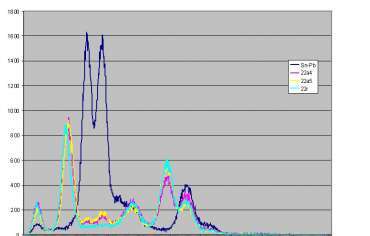X-Ray Fluorescence spectroscopy (XRF)
X-Ray Fluorescence spectroscopy (XRF) enables rapid identification of the elements that comprise a sample. Chemical bonding information is not revealed; hence the technique applies mostly to metals and plating analysis. XRF is particularly useful to detect lead or lead residue in devices that are alleged to be lead-free. Since vacuum is not required, large samples can be readily analyzed. Plating thickness can be verified rapidly and non-destructively, without the need for cross-section.

Detection of residual Sn/Pb (pink and yellow traces) in samples alleged to be lead-free.
Typical applications
Material composition
Plating thickness
Counterfeit detection
RoHS compliance
Jewellery assessment for metallic content
Material composition
Plating thickness
Counterfeit detection
RoHS compliance
Jewellery assessment for metallic content
